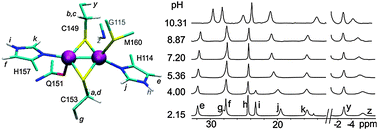Native CuA redox sites are largely resilient to pH variations within a physiological range†
Abstract
Previous studies on engineered CuA centres have shown that one of the

* Corresponding authors
a
INQUIMAE-CONICET and Departamento de Química Inorgánica, Analítica y Química Física, Facultad de Ciencias Exactas y Naturales, Universidad de Buenos Aires, Ciudad Universitaria Pab. 2, C1428EHA Buenos Aires, Argentina
E-mail:
dhmurgida@qi.fcen.uba.ar
b
Instituto de Biología Molecular y Celular de Rosario (IBR), CONICET and Facultad de Ciencias Bioquímicas y Farmacéuticas, Universidad Nacional de Rosario, Predio CONICET Rosario, Ocampo y Esmeralda, 2000 Rosario, Argentina
E-mail:
vila@ibr-conicet.gov.ar
Previous studies on engineered CuA centres have shown that one of the

 Please wait while we load your content...
Something went wrong. Try again?
Please wait while we load your content...
Something went wrong. Try again?
D. Alvarez-Paggi, L. A. Abriata, D. H. Murgida and A. J. Vila, Chem. Commun., 2013, 49, 5381 DOI: 10.1039/C3CC40457A
To request permission to reproduce material from this article, please go to the Copyright Clearance Center request page.
If you are an author contributing to an RSC publication, you do not need to request permission provided correct acknowledgement is given.
If you are the author of this article, you do not need to request permission to reproduce figures and diagrams provided correct acknowledgement is given. If you want to reproduce the whole article in a third-party publication (excluding your thesis/dissertation for which permission is not required) please go to the Copyright Clearance Center request page.
Read more about how to correctly acknowledge RSC content.
 Fetching data from CrossRef.
Fetching data from CrossRef.
This may take some time to load.
Loading related content
